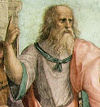- Chariot Allegory
-
- A more elaborate "chariot allegory" is found in the much older Indian work Katha Upanishad, and another in the story of Vajira.

Part of a series on Plato Early life · Works · Platonism
Epistemology · Idealism / Realism
Theory of Forms
Form of the Good
Third man argument
Euthyphro dilemma · Five regimes
Philosopher kingAllegories and metaphors Ring of Gyges · The cave
The divided line · The sun
Ship of state · Myth of Er
The chariotRelated articles The Academy in Athens
Socratic problem
Commentaries on Plato
Middle Platonism · Neoplatonism
Neoplatonism and ChristianityPlato, in his dialogue Phaedrus (sections 246a - 254e), uses the Chariot Allegory to explain his view of the human soul. He does this in the dialogue through the character of Socrates, who uses it in a discussion of the merit of Love as "divine madness".
Plato paints the picture of a Charioteer driving a chariot pulled by two winged horses:
"First the charioteer of the human soul drives a pair, and secondly one of the horses is noble and of noble breed, but the other quite the opposite in breed and character. Therefore in our case the driving is necessarily difficult and troublesome." [1]
The Charioteer represents intellect, reason, or the part of the soul that must guide the soul to truth; one horse represents rational or moral impulse or the positive part of passionate nature (e.g., righteous indignation); while the other represents the soul's irrational passions, appetites, or concupiscent nature. The Charioteer directs the entire chariot/soul, trying to stop the horses from going different ways, and to proceed towards enlightenment.
Contents
Journey
Plato describes a "great circuit" which souls make as they follow the gods in the path of enlightenment. Those few souls which are fully enlightened are able to see the world of the forms in all its glory. Some souls have difficulty controlling the black horse, even with the help of the white horse. They may bob up into the world of the forms, but at other times enlightenment is hidden from them. If overcome by the black horse or forgetfulness, the soul loses its wings and is pulled down to earth.
Should that happen, the soul is incarnated into one of nine kinds of person, according to how much truth it beheld. In order of decreasing levels of truth seen, the categories are: (1) philosophers, lovers of beauty, men of culture, or those dedicated to love; (2) law-abiding kings or civic leaders; (3) politicians, estate-managers or businessmen; (4) ones who specialize in bodily health; (5) prophets or mystery cult participants; (6) poets or imitative artists; (7) craftsmen or farmers; (8) sophists or demagogues; and (9) tyrants.[2]
One need not suppose, of course, that Plato intended this as a literal discussion of metempsychosis or reincarnation: perhaps he meant it figuratively.[3]
Plato does not see the human soul as a sort of patchwork of emotions and concepts; this differs from the views of many philosophers of his time. Instead he views the soul as a sort of composite, in which many different elements blend together and affect each other. He uses the allegory of the charioteer to explain that love is a reflection of love of the forms, and is thus a "divine madness". [disambiguation needed]
References
- ^ Phaedrus, section 246b, Retrieved 2010-11-17.
- ^ Plato; Jowett, Benjamin. "Phaedrus, p 41". Project Gutenberg. http://www.gutenberg.org/catalog/world/readfile?pageno=41&fk_files=39488. Retrieved 2006-12-05.
- ^ Dunkle, Roger. "Plato's Republic". AbleMedia. http://ablemedia.com/ctcweb/netshots/republic.htm. Retrieved 2007-02-02.
See also
External links
- Phaedrus (English and Greek text) - Perseus Digital Library
- Phaedrus Chariot Allegory - Full text (hyperlinked) and commentary
Wikimedia Foundation. 2010.
